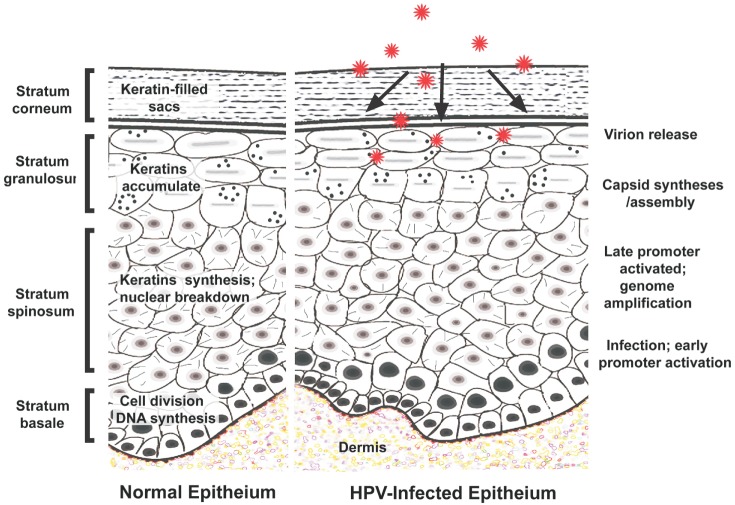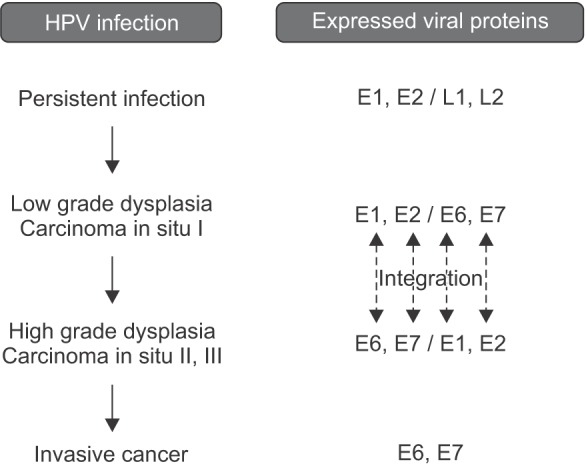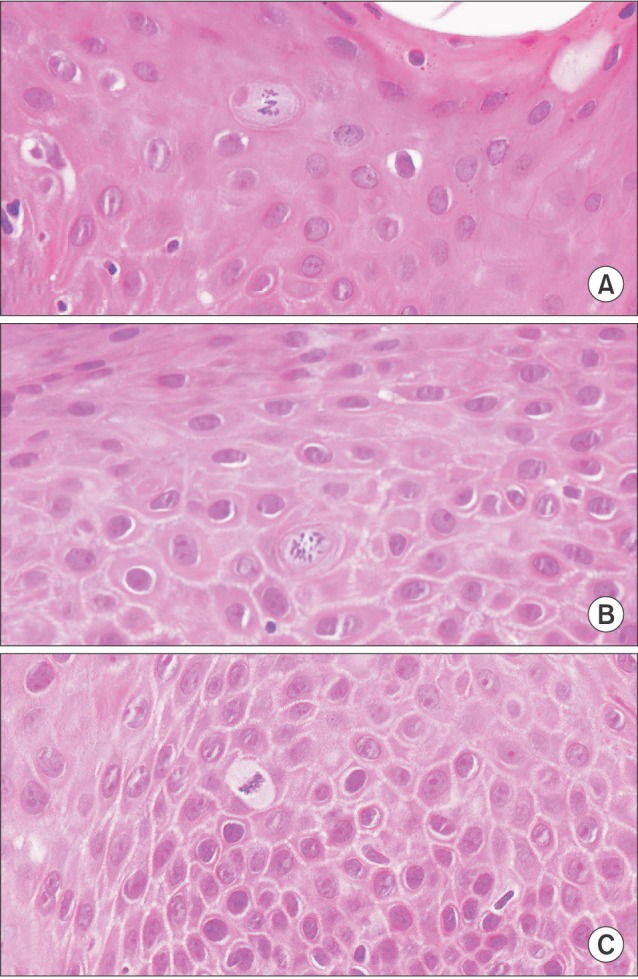J Korean Assoc Oral Maxillofac Surg.
2016 Dec;42(6):327-336. 10.5125/jkaoms.2016.42.6.327.
Human papilloma virus in oral cancer
- Affiliations
-
- 1Oral and Maxillofacial Microvascular Reconstruction Lab, Brong Ahafo Regional Hospital, Sunyani, Ghana. smin5@snu.ac.kr
- 2Department of Oral and Maxillofacial Surgery, Dental Research Institute, School of Dentistry, Seoul National University, Seoul, Korea.
- KMID: 2363999
- DOI: http://doi.org/10.5125/jkaoms.2016.42.6.327
Abstract
- Cervical cancer is the second most prevalent cancer among women, and it arises from cells that originate in the cervix uteri. Among several causes of cervical malignancies, infection with some types of human papilloma virus (HPV) is well known to be the greatest cervical cancer risk factor. Over 150 subtypes of HPV have been identified; more than 40 types of HPVs are typically transmitted through sexual contact and infect the anogenital region and oral cavity. The recently introduced vaccine for HPV infection is effective against certain subtypes of HPV that are associated with cervical cancer, genital warts, and some less common cancers, including oropharyngeal cancer. Two HPV vaccines, quadrivalent and bivalent types that use virus-like particles (VLPs), are currently used in the medical commercial market. While the value of HPV vaccination for oral cancer prevention is still controversial, some evidence supports the possibility that HPV vaccination may be effective in reducing the incidence of oral cancer. This paper reviews HPV-related pathogenesis in cancer, covering HPV structure and classification, trends in worldwide applications of HPV vaccines, effectiveness and complications of HPV vaccination, and the relationship of HPV with oral cancer prevalence.
Keyword
MeSH Terms
Figure
Cited by 1 articles
-
Clinical diagnostic guidelines of allergic rhinitis: comprehensive treatment and consideration of special circumstances
Young Hyo Kim, Sang Min Lee, Mi-Ae Kim, Hyeon-Jong Yang, Jeong-Hee Choi, Dong-Kyu Kim, Young Yoo, Bong-Seong Kim, Won-Young Kim, Jeong Hee Kim, So Yeon Park, Keejae Song, Min-Suk Yang, Young-Mok Lee, Hyun Jong Lee, Jae-Hong Cho, Hye Mi Jee, Yang Park, Woo Yong Bae, Young-Il Koh,
J Korean Med Assoc. 2017;60(3):257-269. doi: 10.5124/jkma.2017.60.3.257.
Reference
-
1. Sun JR, Kim SM, Seo MH, Kim MJ, Lee JH, Myoung H. Oral cancer incidence based on annual cancer statistics in Korea. J Korean Assoc Oral Maxillofac Surg. 2012; 38:20–28.
Article2. Forman D, Bray F, Brewster DH, Gombe Mbalawa C, Kohler B, Piñeros M, et al. Cancer incidence in five continents Vol. X. Lyon: IARC Scientific Publication 164;2014. .3. Walboomers JM, Jacobs MV, Manos MM, Bosch FX, Kummer JA, Shah KV, et al. Human papillomavirus is a necessary cause of invasive cervical cancer worldwide. J Pathol. 1999; 189:12–19. PMID: 10451482.
Article4. van der Marel J, Berkhof J, Ordi J, Torné A, Del Pino M, van Baars R, et al. Attributing oncogenic human papillomavirus genotypes to high-grade cervical neoplasia: which type causes the lesion? Am J Surg Pathol. 2015; 39:496–504. PMID: 25353286.5. Bosch FX, Lorincz A, Muñoz N, Meijer CJ, Shah KV. The causal relation between human papillomavirus and cervical cancer. J Clin Pathol. 2002; 55:244–265. PMID: 11919208.
Article6. Muñoz N, Bosch FX, de Sanjosé S, Herrero R, Castellsagué X, Shah KV, et al. Epidemiologic classification of human papillomavirus types associated with cervical cancer. N Engl J Med. 2003; 348:518–527. PMID: 12571259.
Article7. de Villiers EM, Fauquet C, Broker TR, Bernard HU, zur Hausen H. Classification of papillomaviruses. Virology. 2004; 324:17–27. PMID: 15183049.
Article8. Buck CB, Cheng N, Thompson CD, Lowy DR, Steven AC, Schiller JT, et al. Arrangement of L2 within the papillomavirus capsid. J Virol. 2008; 82:5190–5197. PMID: 18367526.
Article9. zur Hausen H. Papillomaviruses and cancer: from basic studies to clinical application. Nat Rev Cancer. 2002; 2:342–350. PMID: 12044010.
Article10. Rautava J, Syrjänen S. Biology of human papillomavirus infections in head and neck carcinogenesis. Head Neck Pathol. 2012; 6(Suppl 1):S3–S15. PMID: 22782219.
Article11. Lizano M, Berumen J, García-Carrancá A. HPV-related carcinogenesis: basic concepts, viral types and variants. Arch Med Res. 2009; 40:428–434. PMID: 19853182.
Article12. Cardoso JC, Calonje E. Cutaneous manifestations of human papillomaviruses: a review. Acta Dermatovenerol Alp Pannonica Adriat. 2011; 20:145–154. PMID: 22131115.13. Orth G. Host defenses against human papillomaviruses: lessons from epidermodysplasia verruciformis. Curr Top Microbiol Immunol. 2008; 321:59–83. PMID: 18727487.
Article14. Lazarczyk M, Cassonnet P, Pons C, Jacob Y, Favre M. The EVER proteins as a natural barrier against papillomaviruses: a new insight into the pathogenesis of human papillomavirus infections. Microbiol Mol Biol Rev. 2009; 73:348–370. PMID: 19487731.
Article15. Stoler MH. Human papillomaviruses and cervical neoplasia: a model for carcinogenesis. Int J Gynecol Pathol. 2000; 19:16–28. PMID: 10638450.
Article16. Kreimer AR, Clifford GM, Boyle P, Franceschi S. Human papillomavirus types in head and neck squamous cell carcinomas worldwide: a systematic review. Cancer Epidemiol Biomarkers Prev. 2005; 14:467–475. PMID: 15734974.
Article17. Miralles-Guri C, Bruni L, Cubilla AL, Castellsagué X, Bosch FX, de Sanjosé S. Human papillomavirus prevalence and type distribution in penile carcinoma. J Clin Pathol. 2009; 62:870–878. PMID: 19706632.
Article18. Campisi G, Panzarella V, Giuliani M, Lajolo C, Di Fede O, Falaschini S, et al. Human papillomavirus: its identity and controversial role in oral oncogenesis, premalignant and malignant lesions (review). Int J Oncol. 2007; 30:813–823. PMID: 17332919.19. Femiano F. Papilloma virus. Review of the literature. Note II. Diagnosis and treatment. Minerva Stomatol. 2000; 49:179–186. PMID: 11040544.20. Miller CS, Johnstone BM. Human papillomavirus as a risk factor for oral squamous cell carcinoma: a meta-analysis, 1982-1997. Oral Surg Oral Med Oral Pathol Oral Radiol Endod. 2001; 91:622–635. PMID: 11402272.
Article21. Syrjänen K, Mäntyjärvi R, Saarikoski S, Väyrynen M, Syrjänen S, Parkkinen S, et al. Factors associated with progression of cervical human papillomavirus (HPV) infections into carcinoma in situ during a long-term prospective follow-up. Br J Obstet Gynaecol. 1988; 95:1096–1102. PMID: 2849985.22. Pfister H. Human papillomaviruses and skin cancer. Semin Cancer Biol. 1992; 3:263–271. PMID: 1335790.23. Münger K, Werness BA, Dyson N, Phelps WC, Harlow E, Howley PM. Complex formation of human papillomavirus E7 proteins with the retinoblastoma tumor suppressor gene product. EMBO J. 1989; 8:4099–4105. PMID: 2556261.
Article24. Werness BA, Levine AJ, Howley PM. Association of human papillomavirus types 16 and 18 E6 proteins with p53. Science. 1990; 248:76–79. PMID: 2157286.
Article25. Santoro V, Pozzuoli ML, Colella G. Role of human papilloma virus in precancerous and cancerous lesions of the oral cavity. Review of the literature. Minerva Stomatol. 1997; 46:595–601. PMID: 9489355.26. Fornatora ML, Jones AC, Kerpel S, Freedman PD. It's time to modernize our approach to oral HPV lesions. Oral Surg Oral Med Oral Pathol Oral Radiol Endod. 2001; 91:494–496. PMID: 11346722.
Article27. Park MW, Cho YA, Kim SM, Myoung H, Lee JH, Lee SK. Focal epithelial hyperplasia arising after delivery of metal-ceramic fixed dental prosthesis. J Adv Prosthodont. 2014; 6:555–558. PMID: 25558348.
Article28. IARC Working Group on the Evaluation of Carcinogenic Risks to Humans. IARC monographs on the evaluation of carcinogenic risks to humans: IARC monographs, volume 100B. A review of human carcinogens. B. Biological agents. Lyon: International Agency for Research on Cancer;2012. p. 278–280.29. Fakhry C, Westra WH, Li S, Cmelak A, Ridge JA, Pinto H, et al. Improved survival of patients with human papillomavirus-positive head and neck squamous cell carcinoma in a prospective clinical trial. J Natl Cancer Inst. 2008; 100:261–269. PMID: 18270337.
Article30. Dayyani F, Etzel CJ, Liu M, Ho CH, Lippman SM, Tsao AS. Meta-analysis of the impact of human papillomavirus (HPV) on cancer risk and overall survival in head and neck squamous cell carcinomas (HNSCC). Head Neck Oncol. 2010; 2:15. PMID: 20587061.
Article31. Bouda M, Gorgoulis VG, Kastrinakis NG, Giannoudis A, Tsoli E, Danassi-Afentaki D, et al. "High risk" HPV types are frequently detected in potentially malignant and malignant oral lesions, but not in normal oral mucosa. Mod Pathol. 2000; 13:644–653. PMID: 10874669.
Article32. Kojima A, Maeda H, Sugita Y, Tanaka S, Kameyama Y. Human papillomavirus type 38 infection in oral squamous cell carcinomas. Oral Oncol. 2002; 38:591–596. PMID: 12167437.
Article33. Kim KS, Park SA, Ko KN, Yi S, Cho YJ. Current status of human papillomavirus vaccines. Clin Exp Vaccine Res. 2014; 3:168–175. PMID: 25003090.
Article34. Snow AN, Laudadio J. Human papillomavirus detection in head and neck squamous cell carcinomas. Adv Anat Pathol. 2010; 17:394–403. PMID: 20966645.
Article35. Gillison ML, D'Souza G, Westra W, Sugar E, Xiao W, Begum S, et al. Distinct risk factor profiles for human papillomavirus type 16-positive and human papillomavirus type 16-negative head and neck cancers. J Natl Cancer Inst. 2008; 100:407–420. PMID: 18334711.
Article36. Heck JE, Berthiller J, Vaccarella S, Winn DM, Smith EM, Shan'gina O, et al. Sexual behaviours and the risk of head and neck cancers: a pooled analysis in the International Head and Neck Cancer Epidemiology (INHANCE) consortium. Int J Epidemiol. 2010; 39:166–181. PMID: 20022926.
Article37. Lajer CB, von Buchwald C. The role of human papillomavirus in head and neck cancer. APMIS. 2010; 118:510–519. PMID: 20553531.
Article38. Mishra R. Biomarkers of oral premalignant epithelial lesions for clinical application. Oral Oncol. 2012; 48:578–584. PMID: 22342569.
Article39. Napier SS, Speight PM. Natural history of potentially malignant oral lesions and conditions: an overview of the literature. J Oral Pathol Med. 2008; 37:1–10. PMID: 18154571.
Article40. Villa A, Villa C, Abati S. Oral cancer and oral erythroplakia: an update and implication for clinicians. Aust Dent J. 2011; 56:253–256. PMID: 21884139.
Article41. Greer RO Jr, Meyers A, Said SM, Shroyer KR. Is p16(INK4a) protein expression in oral ST lesions a reliable precancerous marker? Int J Oral Maxillofac Surg. 2008; 37:840–846. PMID: 18606525.
Article42. Leemans CR, Braakhuis BJ, Brakenhoff RH. The molecular biology of head and neck cancer. Nat Rev Cancer. 2011; 11:9–22. PMID: 21160525.
Article43. Feller L, Wood NH, Khammissa RA, Lemmer J. Human papillomavirus-mediated carcinogenesis and HPV-associated oral and oropharyngeal squamous cell carcinoma. Part 2: Human papillomavirus associated oral and oropharyngeal squamous cell carcinoma. Head Face Med. 2010; 6:15. PMID: 20633288.
Article44. Markowitz LE, Tsu V, Deeks SL, Cubie H, Wang SA, Vicari AS, et al. Human papillomavirus vaccine introduction--the first five years. Vaccine. 2012; 30(Suppl 5):F139–F148. PMID: 23199957.45. Castle PE, Maza M. Prophylactic HPV vaccination: past, present, and future. Epidemiol Infect. 2016; 144:449–468. PMID: 26429676.
Article46. zur Hausen H, Gissmann L, Steiner W, Dippold W, Dreger I. Human papilloma viruses and cancer. Bibl Haematol. 1975; (43):569–571.47. Zhou J, Sun XY, Stenzel DJ, Frazer IH. Expression of vaccinia recombinant HPV 16 L1 and L2 ORF proteins in epithelial cells is sufficient for assembly of HPV virion-like particles. Virology. 1991; 185:251–257. PMID: 1656586.
Article48. Baker TS, Newcomb WW, Olson NH, Cowsert LM, Olson C, Brown JC. Structures of bovine and human papillomaviruses. Analysis by cryoelectron microscopy and three-dimensional image reconstruction. Biophys J. 1991; 60:1445–1456. PMID: 1663794.
Article49. zur Hausen H. Papillomaviruses in the causation of human cancers: a brief historical account. Virology. 2009; 384:260–265. PMID: 19135222.50. Kumaraswamy KL, Vidhya M. Human papilloma virus and oral infections: an update. J Cancer Res Ther. 2011; 7:120–127. PMID: 21768696.
Article51. Syrjänen KJ, Pyrhönen S, Syrjänen SM, Lamberg MA. Immunohistochemical demonstration of human papilloma virus (HPV) antigens in oral squamous cell lesions. Br J Oral Surg. 1983; 21:147–153. PMID: 6307342.
Article52. Cox MF, Scully C, Maitland N. Viruses in the aetiology of oral carcinoma? Examination of the evidence? Br J Oral Maxillofac Surg. 1991; 29:381–387. PMID: 1772858.
Article53. Murray M. Progress in preventing cervical cancer: updated evidence on vaccination and screening [Internet]. Seattle (WA): Outlook 2010;27(2)/Program for Appropriate Technology in Health (PATH);cited 2016 Aug 27. Available from: http://www.path.org/publications/files/RH_outlook_27_2.pdf.54. Recommended adult immunization schedule--United States, 2012 [Internet]. Atlanta (GA): Centers for Disease Control and Prevention;cited 2016 Aug 27. Available from: http://www.cdc.gov/mmwr/preview/mmwrhtml/mm6104a9.htm.55. Palefsky JM, Giuliano AR, Goldstone S, Moreira ED Jr, Aranda C, Jessen H, et al. HPV vaccine against anal HPV infection and anal intraepithelial neoplasia. N Engl J Med. 2011; 365:1576–1585. PMID: 22029979.
Article56. Huygen F, Verschueren K, McCabe C, Stegmann JU, Zima J, Mahaux O, et al. Investigating reports of complex regional pain syndrome: an analysis of HPV-16/18-adjuvanted vaccine post-licensure data. EBioMedicine. 2015; 2:1114–1121. PMID: 26501109.
Article57. Garçon N, Chomez P, Van Mechelen M. GlaxoSmithKline Adjuvant Systems in vaccines: concepts, achievements and perspectives. Expert Rev Vaccines. 2007; 6:723–739. PMID: 17931153.
Article58. Kash N, Lee MA, Kollipara R, Downing C, Guidry J, Tyring SK. Safety and efficacy data on vaccines and immunization to human papillomavirus. J Clin Med. 2015; 4:614–633. PMID: 26239350.
Article59. Kols A, Sherris J. HPV vaccines: promise and challenges [Internet]. Seattle (WA): PATH;cited 2016 Aug 27. Available from: http://citeseerx.ist.psu.edu/viewdoc/download?doi=10.1.1.424.5575&rep=rep1&type=pdf.60. Haupt RM, Sings HL. The efficacy and safety of the quadrivalent human papillomavirus 6/11/16/18 vaccine gardasil. J Adolesc Health. 2011; 49:467–475. PMID: 22018560.
Article61. McNeil C. Who invented the VLP cervical cancer vaccines? J Natl Cancer Inst. 2006; 98:433. PMID: 16595773.
Article62. Shi L, Sings HL, Bryan JT, Wang B, Wang Y, Mach H, et al. GARDASIL: prophylactic human papillomavirus vaccine development: from bench top to bed-side. Clin Pharmacol Ther. 2007; 81:259–264. PMID: 17259949.63. Vichnin M, Bonanni P, Klein NP, Garland SM, Block SL, Kjaer SK, et al. An overview of quadrivalent human papillomavirus vaccine safety: 2006 to 2015. Pediatr Infect Dis J. 2015; 34:983–991. PMID: 26107345.64. Slade BA, Leidel L, Vellozzi C, Woo EJ, Hua W, Sutherland A, et al. Postlicensure safety surveillance for quadrivalent human papillomavirus recombinant vaccine. JAMA. 2009; 302:750–757. PMID: 19690307.
Article65. Garland SM, Cheung TH, McNeill S, Petersen LK, Romaguera J, Vazquez-Narvaez J, et al. Safety and immunogenicity of a 9-valent HPV vaccine in females 12-26 years of age who previously received the quadrivalent HPV vaccine. Vaccine. 2015; 33:6855–6864. PMID: 26411885.
Article66. Labadie J. Postlicensure safety evaluation of human papilloma virus vaccines. Int J Risk Saf Med. 2011; 23:103–112. PMID: 21673418.
Article67. Brotherton JM, Ogilvie GS. Current status of human papillomavirus vaccination. Curr Opin Oncol. 2015; 27:399–404. PMID: 26258273.
Article68. Brisson M, Laprise JF, Chesson HW, Drolet M, Malagón T, Boily MC, et al. Health and economic impact of switching from a 4-valent to a 9-valent HPV vaccination program in the United States. J Natl Cancer Inst. 2015; DOI: 10.1093/jnci/djv282.
Article69. Bazan SB, de Alencar Muniz Chaves A, Aires KA, Cianciarullo AM, Garcea RL, Ho PL. Expression and characterization of HPV-16 L1 capsid protein in Pichia pastoris. Arch Virol. 2009; 154:1609–1617. PMID: 19756360.
Article70. Rybicki EP, Williamson AL, Meyers A, Hitzeroth II. Vaccine farming in Cape Town. Hum Vaccin. 2011; 7:339–348. PMID: 21358269.
Article71. Majewski S, Jablonska S. Immunology of HPV infection and HPV-associated tumors. Int J Dermatol. 1998; 37:81–95. PMID: 9542660.73. Tindle RW, Frazer IH. Immune response to human papillomaviruses and the prospects for human papillomavirus-specific immunisation. Curr Top Microbiol Immunol. 1994; 186:217–253. PMID: 8205843.
Article74. Arya SC, Agarwal N. Extended coverage of HPV vaccination in middle-aged adults to prevent oropharyngeal cancers. Hum Vaccin Immunother. 2012; 8:959. PMID: 22777098.
Article75. Ramqvist T, Dalianis T. An epidemic of oropharyngeal squamous cell carcinoma (OSCC) due to human papillomavirus (HPV) infection and aspects of treatment and prevention. Anticancer Res. 2011; 31:1515–1519. PMID: 21617204.76. Matsushita K, Sasagawa T, Miyashita M, Ishizaki A, Morishita A, Hosaka N, et al. Oral and cervical human papillomavirus infection among female sex workers in Japan. Jpn J Infect Dis. 2011; 64:34–39. PMID: 21266753.77. Zil-A-Rubab , Baig S, Siddiqui A, Nayeem A, Salman M, Qidwai MA, et al. Human papilloma virus--role in precancerous and cancerous oral lesions of tobacco chewers. J Pak Med Assoc. 2013; 63:1295–1298. PMID: 24392564.
- Full Text Links
- Actions
-
Cited
- CITED
-
- Close
- Share
- Similar articles
-
- A Case of Squamous Papilloma in Oral Mucosa
- Human Papilloma Virus-Related Metachronous Tracheal Cancer in a Patient with Tonsillar Cancer
- Oral Squamous Cell Papilloma in Tongue of Ventral Area: A Case Report
- Complete Remission of Recalcitrant Plantar Wart Treated with Quadrivalent Human Papilloma Virus Vaccine
- Is human papilloma virus vaccination effective for oral cancer?




